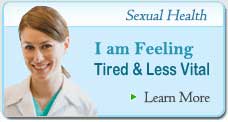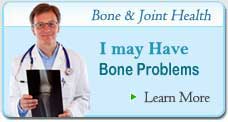» Anti-Aging
» Bones Joints & Muscle Health
- 5 Proven Remedies for Plantar Fasciitis
- Chair Yoga for Seniors: Keys to Maintaining Flexibility
- Restless Leg Syndrome Causing You Pain & Lost Sleep? Learn What IS Known About RLS
- Must Know Lyme Disease Information - You Might Be Surprised To Find Out...
- How To Prevent Falls And Reduce Accidents As We Age
» Cardiovascular Health
» Chronic Pain Management
» Dental Health & Wellness
» Digestive Health Problems
» Health Care
» Mental Health
» Sexual Health
» Skin Care

How To Prevent Osteoporosis – Are Bone Fractures Inevitable?
Imagine not being able to hug your children in an attempt to avoid the unexpected crack and searing pain caused from a bone fracture of glass brittle bones caused by Osteoporosis. This situation is an all too common reality as Osteoporosis is a serious condition that affects many aging adults today.
However, there is still a lot of confusion and misinformation out there regarding this bone disease.
| Rating | Recommended | Description | Review | ||
|---|---|---|---|---|---|
 |  | Ruby Calcium Osteoporsis Fighting Benefits
| Find Out More | ||
 |  | Vitamin D 2000 Bone Benefits
| Find Out More | ||
 |  | Ageless Select Bone & Joint Benefits
| Find Out More |
In the following we will attempt a comprehensive overview so that you will fully understand what is osteoporosis, what causes it, what symptoms you will face, and what treatments are available.
What is Osteoporosis?
Osteoporosis is a bone disease. The name means porous bones, which is a fairly good description of the effects of the disease. When you are affected by osteoporosis, you suffer from a loss of bone density.
This results in your bones being weakened and puts you at greater risk of fracture and other serious injury than someone with healthy bones.
Symptoms of Osteoporosis
One of the most troubling aspects of osteoporosis is that often people do not know they have it until after they have suffered a bone fracture (a common symptom). It is a subtle disease that does not have any noticeable symptoms in the early stages.
However, in later stages of the disease after significant bone loss has occurred, there are several distinct symptoms.
These include:
- fractures after no known trauma or after very slight trauma
- tenderness or pain in the bones
- lower back and neck pain resulting from spinal fractures
- loss of height
- a stooping or hunched posture
Often osteoporosis is not diagnosed until after the first fractures. However, for patients with significant risk factors doctors may perform regular bone density tests to watch for the onset of this disease.
This requires a specialized test known as a DEXA scan. Alternately, some practitioners use a modified CT scan to check spine density levels. Normal x-rays are not useful in diagnosing it except in advanced cases.
What Are The Causes
There are two basic causes of this disease. The first is when new bone ceases to be formed. As the body ages, new bone should constantly be forming to adapt to stresses and replace old bone that deteriorates over time. Sometimes the body is no longer able to create enough new bone resulting in a net loss.
The other cause is when too much old bone is reabsorbed. This is a natural and necessary process to some degree.
The body needs to reuse the calcium and phosphate in bones, and to remove brittle old bone to make room for new growth. However, sometimes the body takes too much and new growth cannot replace it quickly enough.
The end result of both of these processes is weak and brittle bones.
Osteoporosis mainly affects older people as a major cause is hormonal changes due to aging. For women, estrogen production drops significantly after menopause and this can trigger bone loss. Lowered levels of testosterone in older men, male andropause, has also been linked to osteoporosis.
However, this disease affects women approximately twice as often as it affects men.
In addition, lifestyle factors that affect bone growth can cause osteoporosis. For example, being confined to a bed or otherwise having limited mobility can lead to a lack of new bone growth.
Taking certain medications such as corticosteroids, and ppi inhibitors such as nexium for prolonged periods has also been linked to this disease.
A lack of dietary calcium or eating disorders which prevent consumption or absorption of calcium can also cause osteoporosis.
Potential Risk Factors
Like many diseases, certain factors may increase your risk of developing osteoporosis. Some of these cannot be changed, such as age and sex. However, there are some lifestyle factors that can increase your likelihood of developing osteoporosis, and if managed can help you avoid bone problems.
Risk factors that cannot be changed include aging, since osteoporosis is found almost exclusively in people over age 50. Sex is another factor. Women are twice as likely to be affected as men. Even your body type can affect it, as people with smaller builds and fine bone structure are at increased risk of fracturing.
Osteoporosis can also be genetic. Researchers have found more than 30 genes which may affect the development of the disease, and it is known to be highly heritable. A family history of it can be a significant risk factor.
In addition, certain ethnic groups are considered higher risk. It can be found in all ethnic groups, but people of European or Asian descent are known to be more prone to developing osteoporosis symptoms.
Fortunately, there are some risk factors that can be modified or eliminated. One of the most common factors is excessive alcohol use. Although some studies have indicated that moderate alcohol consumption can actually improve bone density and strength to some degree, heavy alcohol consumption is known to deplete bone density.
This is due in part to the fact that it can prevent the body from absorbing calcium efficiently from dietary sources, which forces it to leach calcium from the bones.
A sedentary lifestyle can also increase your risk of developing this disease. Bones naturally remodel due to stress and movement, so too little movement interferes with normal growth and remodeling. Essentially, use them or lose them.
Malnutrition is another major factor. This does not necessarily mean starvation.
Your body needs certain vitamins and minerals to absorb calcium and create new bone, and an inadequate supply can lead to decreased bone density.
Additionally, many sufferers have been found to be lacking essential vitamins and minerals in their diet that allow for calcium absorption.
Also, highly acidic diets have been shown in studies to have a relationship with calcium levels and healthy nutrition. You could be eating well, but missing a few key components in your diet to help prevent osteoporosis.
Vitamin D is one of the most important vitamins for healthy bones, and many people do not get enough. Our bodies create it naturally from sun exposure, but people who spend a great deal of time indoors or live in certain climates may not get enough.
In those cases it is important to supplement it with dietary sources.
Osteoporosis Treatment Options
Osteoporosis is a degenerative disease and most treatments are based on preventing further deterioration and making the patient comfortable. Since fractures and aches are common, pain medication be prescribed to deal with the symptoms, but will not address the underlying causes.
Your doctor will be able to discuss the current treatment options provided by medication currently available to help fight bone deterioration.
Diet and exercise are also important treatments. Your doctor will help you develop a balanced diet to ensure you are getting all the nutrients you need for healthy bones.
In addition, you will plan an exercise routine that encourages healthy bone remodeling without increasing your risk of fracture. Regular low impact exercise prior to developing symptoms can help avoid osteoporosis from occurring.
By focusing on diet and exercise, namely, making sure you are consuming the vitamins and minerals your body needs to process calcium in a healthy manner, as well as moderate low impact physical activity you can decrease your risk of developing the disease.
Osteoporosis is a serious disease, but there are many ways to lower your risk of developing it.
If you already have it, there are treatments and lifestyle changes you can implement to improve your bone strength and prevent further bone loss so you can live a long and healthy life after diagnosis.
» Discover A Powerful Natural Way To
Stop Calcium Loss and Improve Bone Health
You May Also Find Informative:
Aging Fit - Health Research & Information
Better Health. Energy. Quality.






